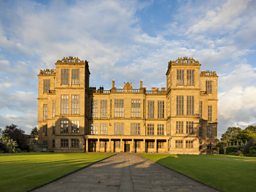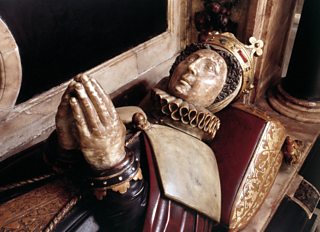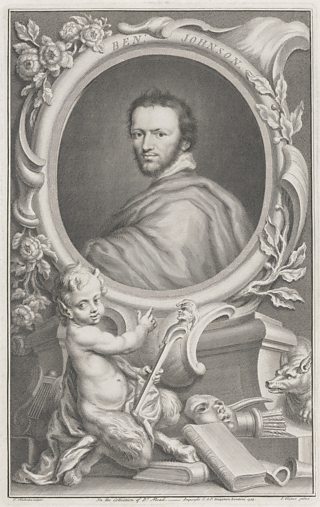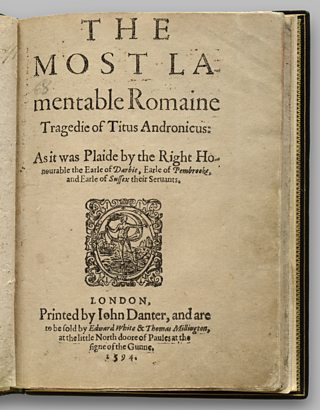From Shakespeare to Harry Potter
How Hardwick Hall cast its spell over the Bard and the boy wizard.
It is no stranger to being at the centre of drama, having made a big screen appearance in the successful Harry Potter film franchise, but centuries earlier this stunning country house between Chesterfield and Mansfield may also have been among the first locations where Shakespeare’s early plays were performed outside of London.
One of the first Elizabethan performing companies to put on a play at Hardwick Hall was the Pembroke’s Men – a troupe in which Shakespeare himself may have performed.
-
![]()
Much ado near me
Hear more Shakespeare stories on BBC Radio Derby
-
![]()
Shakespeare Festival 2016
The BBC celebrates the genius of the bard

The year is 1600, and Hardwick Hall is the new home to one of the wealthiest women in England, Elizabeth Talbot, Countess of Shrewsbury, known to all as ‘Bess of Hardwick’.

Prof. Ted McGee, co-editor of the Derbyshire edition of the Records of Early English Drama, takes up the story: “Travelling players had played at Hardwick Hall four times between 1594 and 1596 and, after a brief hiatus at the time when 'Bess' took up residence there, began to arrive again in 1599.
“One of the first troupes to perform was Pembroke’s Men in February, 1600. This company, which was under the patronage of Henry Herbert, 2nd earl of Pembroke, had several largely unsuccessful provincial tours starting in 1592, when an outbreak of the plague in London prompted many actors to take their shows on the road.
“Shakespeare may have been a member of Pembroke's Men early in the 1590s. Certainly, as the title pages of the earliest texts of these plays note, the company had among the plays in their repertoire Titus Andronicus (1594), Henry VI, Part 3 (1595), and The Taming of a Shrew (1594).
“By 1600, Shakespeare had moved on to the Lord Chamberlain's Men, but he did not have complete control over the publication of his plays let alone of their performance.
“Hardwick Hall, may have been one of the early provincial venues for some of the first plays of the "upstart crow" from Stratford.”
The formidable Bess of Hardwick
By Professor Ted McGee (REED co-editor for Derbyshire) and Professor Emeritus, University of Waterloo, Ontario
When George Talbot, 6th earl of Shrewsbury, died in 1590, his widow Elizabeth became one of the wealthiest women in England, second only to the queen herself.

The Countess of Shrewsbury set about that same year to build a stately home worthy of a queen, because her granddaughter, Lady Arabella Stuart, had a good claim to the throne and might indeed inherit.
The Countess, who had been born in the Hardwick Old Hall, began the building of a grand new house nearby. With the assistance of Robert Smythson, the 'architect' of Longleat House, she oversaw the construction of the magnificent Hardwick Hall, now a National Trust property, and moved into it in 1597, perhaps for her 70th birthday.
She was married four times, rising to become among the highest levels of English nobility, accumulating great wealth along the way. She also built Chatsworth House in Derbyshire and was close to Mary Queen of Scots.
She died at the age of 81 and her body placed in a vault in All Saints Parish Church – now Derby Cathedral - where there is a memorial to her.
Pembroke’s Men and Ben Jonson’s infamous play
Three years prior to Pembroke’s Men performing at Hardwick Hall, they were embroiled in an almighty scandal which landed two of their cast - plus the famous playwright Ben Jonson - in prison.

In the summer of 1597, they put on a performance at the Swan Theatre in London of a new work by Jonson and co-writer Thomas Nashe, called The Isle of Dogs.
A satire, it was immediately suppressed and three actors - Jonson included – were packed off to prison. Jonson was finally released from jail in October that year.
No known copy of The Isle of Dogs exists today so it has been hard for academics to ascertain precisely who the satire clearly upset. It was reported to the authorities for being ‘lewd’ and full of ‘slanderous matter’.
It may be that it was Queen Elizabeth herself being satirised…
From Shakespeare to Harry Potter
Hardwick Hall is more recently famous as a location for another piece of…more modern drama.
As well as being possibly among the early provincial venues for the performance of Shakespeare’s first plays, it is a location used in the Harry Potter and the Deathly Hallows.
The famous house doubles up as the dark and sinister Malfoy Manor in The Deathly Hallows.
Movie bosses loved the building's huge windows and six-tower skyline.
Exterior shots were filmed from a helicopter and the film-makers photographed and measured inside to help shoot indoor scenes at the studio.
Rachel Albanese, the Hall's visitor experience manager, told BBC Radio Derby: "Hardwick Hall was a perfect setting for Malfoy Manor.
"It's a beautiful building and very mysterious. It certainly raises our profile and puts us on the map, not just as a film location but somewhere to visit.
"It couldn't have come at a better time for us as we're in the middle of a major project to move our shop and restaurant down to the stableyards so we can be open all year round."
The Hall was also featured in the 2001 film Anita and Me as well as several television documentaries.
Pembroke’s Men and their links to Shakespeare
This 1594 edition of Titus Andronicus shows that the group of performers known as Pembroke’s Men had Shakespeare’s plays in their repertoire.

Indeed Shakespeare himself may well have been a member of the troupe in the early 1590s, just before he joined with the Lord Chamberlain’s Men.
The early 1590s was a hard time for many acting companies with bubonic plague forcing some of them out of London to perform in the provinces.
In 1593 this particular set of Pembroke’s Men set out on a provincial tour but it was a big disappointment, which we know from famous diarist of the time Philip Henslowe, who indicates that the tour had not taken off and some actors even had to pawn their costumes.
Sally-Beth MacLean, General Editor of Records of Early English Drama, writes: “When the Chamberlain's Men was first formed in late spring 1594, it is very likely that Shakespeare was indeed one of their actors, as well as a contributing playwright, possibly recruited from the remnants of Pembroke’s Men, a company known to have hit hard times the previous year.”
Shakespeare on Tour
From the moment they were written through to the present day, Shakespeare’s plays have continued to enthral and inspire audiences. They’ve been performed in venues big and small – including inns, private houses and emerging provincial theatres.

BBC English Regions is building a digital picture which tracks some of the many iconic moments across the country as we follow the ‘explosion’ in the performance of The Bard’s plays, from his own lifetime to recent times.
Drawing on fascinating new research from Records of Early English Drama (REED), plus the British Library's extensive collection of playbills, as well as expertise from De Montfort University and the Arts and Humanities Research Council, Shakespeare on Tour is a unique timeline of iconic moments of those performances, starting with his own troupe of actors, to highlights from more recent times. Listen out for stories on Shakespeare’s legacy on your BBC Local Radio station from Monday 21 March, 2016.
You never know - you might find evidence of Shakespeare’s footsteps close to home…
Craig Henderson, BBC English Regions
-
![]()
Shakespeare Lives
The nation’s greatest performing arts institutions mark 400 years since the Bard's death
Related Links
Shakespeare on Tour: Around Derby
-
![]()
Acting dynasty comes to Derby Theatre
The Kembles come to Derby
-
![]()
Shakespearean starlet descends on Derby
The formidable professional partnership of Eleanora Tree and Charles Kean
Shakespeare on Tour: Around the country
-
![]()
A wealthy host attracts Shakespeare's actors to Yorkshire
Shakespeare’s King’s Men visit the Clifford family at Londesborough Hall
-
![]()
Norwich gives Shakespeare's company the cold shoulder
Shakespeare's players paid 40 shillings not to perform
-
![]()
Celebrated young actor stars as Hamlet
Child prodigy actor who took theatres by storm in 1804 stars as Hamlet in Stafford
-
![]()
Much Ado about Dracula?
Much Ado About Nothing at the London Lyceum 1883









